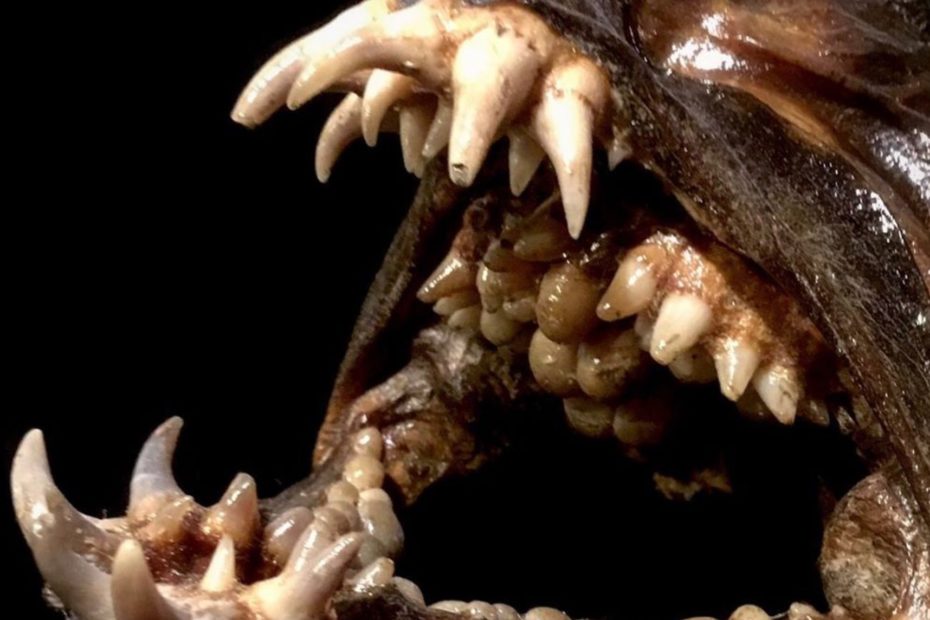25 Bizarre Sea Creatures that Will Have You Questioning If You Ever Want to Play In the Ocean Again
Scientists estimate that anywhere from one-third to two-thirds of sea life has not been discovered yet. That means that there are millions of creatures lurking in the depths waiting to scare the hell out of us. If there are more undiscovered species than there are discovered ones, what else is out there? The thought is enough to send chills down the spine, but you don’t have to let your imagination get the best of you, because we’ve rounded up some of the most troubling monsters that we do actually know about.
Many of us are foregoing travel this year because of the epidemic, but don’t let that missed beach travel get you down! Count your blessings because you could encounter one of these unsavory characters at the sea. Well, to be honest, the odds of swimming next to one of the beings at the beach is low. However, that doesn’t mean they’re not still out there! Here are 25 terrifying sea creatures that will haunt your nightmares and make you wish for dolphins.
Vampire Squid
Ugh! The vampire squid is a small cephalopod found throughout temperate and tropical oceans in extremely deep conditions. Not deep enough, if you ask us. It’s a living fossil! When it’s threatened (who would ever?), it turns its “cape” inside out so that the spines poke out and act like a spiny barrier.
Anglerfish
The anglerfish is a bony fish named for its characteristic mode of predation, in which a fleshy growth from the fish’s head acts as a lure for other fish. Yes, this fish’s body grew its own lure because it’s a predator like that. If you thought it couldn’t get worse, we’re sorry to tell you about how they mate.
Once a male finds a suitable mate, he bites into her belly and latches on until his body fuses with hers. Their skin joins together, and so do their blood vessels, which allows the male to take all the nutrients he needs from his mate’s blood. The two fish fuse into one! Not great!
Atlantic Wolffish
Look at this charmer! The Atlantic wolffish is known by a few names: seawolf, Atlantic catfish, ocean catfish, devil fish, wolf eel, woof, or sea cat. *Sigh* The wolffish is characterized by its chompers and its ability to thrive in cold water. They are commonly caught and enjoyed in the upper Atlantic and in Europe. Which is fine as long as they don’t eat you first!
Goblin Shark
The goblin shark has a fitting name. This terrifying deep-sea shark is considered a living fossil and it and its relatives have existed on the planet for 125 million years!!! This pink-skinned shark has an unusually long snout and highly protrusible jaws. The average goblin is between ten and thirteen feet long. There have been no known attacks on humans from these beasts, but we’re not interested in tempting fate.
Sarcastic Fringehead
The sarcastic fringehead fish is a hardy saltwater fish known for its huge mouth and territorial behavior. The fish is notoriously feisty and when it feels threatened, it looks like this. It’s common for a pair of these guys to get into a territorial battle which involves them aggressively slamming their wide-opened mouths together.
Viperfish
We’re not sure if this will bring you comfort, but viperfish rarely grow larger than two feet long. The fish are characterized by their razor-sharp teeth. While you might think you’re seeing scales here, you’re wrong. Their bodies are covered in a thick, transparent coating of an unknown substance. What!? These predators capture their prey by engaging their photophores, light-producing organs that attract smaller fish. Its teeth are so long it cannot close its mouth, but that comes in useful when hunting. Ew!
Japanese Spider Crab
The Japanese spider crab is one of the largest arthropods in the world. It can measure twelve feet across and weigh fifty pounds. They can live for a hundred years, which is a long time to plot a murder. These crabs love to scavenge and feed off the corpses of other dead animals that fall to the seafloor. Because they are so large, they “decorate” their shells with random things to help disguise them from predators (yes, they have them) like octopi.
Fangtooth Moray Eel
The fangtooth moray is a moray eel of the family Muraenidae found in warmer parts of the eastern Atlantic Ocean, including the Mediterranean Sea and the Canary Islands. It’s characterized by its “glass teeth” which look like glass shards that want to tear you apart. An adult fangtooth can reach up to four feet long. No thanks! Dry forever.
Giant Isopod
A giant isopod is any of the almost 20 species (!) of large isopods in the genus Bathynomus. They are plentiful in the cold, deep waters of the Atlantic, Pacific, and Indian Oceans. They look like giant, evil cockroaches and they are generally around a foot long. However, some have claimed to find specimens almost three feet in size. Three feet! A living fossil these things have been around for a long, long time. Which is understandable, who wants to mess with this?
Pelican Eel
This pelican eel wants to slither right into your next nightmare. The pelican eel is a deep-sea eel rarely seen by humans (usually just before a terror-induced fugue state), though it is infrequently caught in fishing nets. It is the only known member of the genus Eurypharynx and the family Eurypharyngidae. Look at that little hell-light at the end of its tale.
Payara
The payara, Hydrolycus scomberoides, is a species of dogtooth tetra. This predatory fish is found in the Amazon Basin in tropical South America. The fish is characterized by two long fangs protruding from its lower jaw. These are used to impale their prey, mostly smaller fish. These aggressive fish generally grow to be between two and four feet long!
Black Dragonfish
Idiacanthus atlanticus is a barbeled dragonfish of the familyStomiidae, found around the world in southern subtropical and temperate oceans. Female dragonfish generally grow to a length of sixteen inches while their male counterparts only reach two inches in length.
Black dragonfish are bioluminescent, but unlike most predators, which use their light primarily to attract prey, they can see their own light. As a result, the fish can use their light to hunt. Let us get this straight… These fish emit their own light to hunt prey. No thanks, under the covers forever.
Deadly Sea Cucumber
There are many different species of sea cucumbers that look aquatic caterpillars. While they look grosser than menacing, when threatened, these creatures will release a holothurin which is a white sticky like substance from their Cuvierian organ. The substance is toxic to humans and other life stunning many and sometimes even causing death. Some species of sea cucumbers can grow to six feet in length. Nah.
Atlantic Stargazer Fish
Atlantic stargazer or Uranoscopus scaber is a marine, subtropical fish of family Uranoscopidae. Its body is suited for living on the seafloor and is one of few fish capable of bioelectrogenesis, the ability to generate an electric charge. So it just hides at the bottom ocean looking up like this, waiting to shock things. Our feet will never touch the floor of the sea again.
Armored Searobin
Armored searobins, or armored gurnards are a family, Peristediidae, of scorpaeniform fishes found in deep waters all over the world, with most species in tropical regions. They are encased in heavy scales with prominent spines. They have prominent and often elaborate barbels on their chins. The way their fins are structured in such a way that makes searobins look like birds when they fly. Generally, these fish grow between one and two feet in length.
Moray Eel
Moray eels, or Muraenidae, are a family of eels whose members are found worldwide. There are approximately 200 species! Here we have the giant moray eel that can grow to ten feet in length and weigh 65 pounds. Not cool! Giant moray eels secrete a protective mucus over their smooth, scaleless skin which in some species contains a toxin. Ew! While these giant snake-fish might look threatening, most of the time they’d prefer to flee and hide than fight with humans.
Coffinfish
The coffinfish is a species of sea toad of the family Characidae. It is found in salty temperate waters of southwestern Pacific, off the east coast of Australia. So, no going down under any time soon. The skin is densely covered with small to minute spine-like scales. If you thought the pufferfish was the only fish that blew up when threatened, think again. A coffinfish has inflatable gills that it uses to fill its body with water, acting as a defense mechanism.
Do you see that weird thing in between its eyes? That’s a lure used to catch prey with. The coffinfish has a fishing rod on its head. Sigh.
Sheepshead
Look at these uncanny teeth! Look at them! Archosargus probatocephalus, the sheepshead, is a marine fish that grows to 30 inches in length. It’s characterized by six black bars across its body and these chompers in its mouth. The teeth, which closely resemble human teeth, have evolved this way to crush the shells of its prey. These fish love to eat oysters, clams, crabs, and barnacles.
Tassled Scorpionfish
The tasseled scorpionfish, or small-scaled scorpionfish, Scorpaenopsis oxycephala, is a predatory ray-finned fish with venomous spines. It lives in the Indian and Pacific Oceans. It can reach a maximum length of sixteen inches, but you would never know that because its well-camouflaged body is very hard to see. In fact, many swimmers accidentally step on the scorpionfish causing painful injury from the venomous spines. Between this and the stargazer, we’re never putting our feet down again.
Frilled Shark
The frilled shark is one of two extant species of shark in the family Chlamydoselachidae, with a wide but sketchy distribution in the Atlantic and Pacific Oceans. Marvel at the rows and rows and rows and rows of teeth. The teeth number around 300 in all; each tooth is small, with three slender, needle-like cusps alternating with two cusplets. Their long, eel-like bodies can grow to nearly seven feet in length.
Jawfish
Say “hello” to a male Jawfish (Opistognathidae) with a mouthful of babies. Females lay an egg mass and after fertilizing them, the male takes the eggs into his mouth and incubates them for several days or several weeks depending on the species. During this time he does not eat, and his activities are restricted to juggling the eggs in his mouth to aerate them. Not into it.
Asian Sheepshead Wrasse
The Asian sheepshead wrasse, Semicossyphus reticulatus, is a species of wrasse, one of the largest, native to the western Pacific Ocean, where it is only known from around the Korean Peninsula, China, Japan, and the Ogasawara Islands, where it inhabits rocky reef areas. This very interesting fish can change its sex. The fish is a beloved food in Japan and other parts of Asia. What do you think it has on its mind?
Lumpfish
Lumpsuckers or lumpfish are mostly small scorpaeniform marine fish of the family Cyclopteridae. They are found in the cold waters of the Arctic, North Atlantic, and North Pacific oceans. The greatest number of species are found in the North Pacific. As their appearance might suggest, lumpsuckers are poor swimmers. They have modified pelvic fins that it uses to “suck” or stick to surfaces. No thanks to this gooey looking sea monster.
Ghost Shark
Chimaeras are cartilaginous fish in the order Chimaeriformes, known informally as ghost sharks, ratfish, spookfish, or rabbitfish. Just… NO! This order of fish has been around for over 400 million years. In general, ghost sharks grow five feet in length. This thing looks like it straight up came out of the Alien movie. “In Space, No One Can Hear You Scream” should be updated to include the depths of the ocean as well.
YOU MIGHT ALSO LIKE: 7 of the Strangest Animals on Earth that You Can’t Unsee
Grenadier “Raittail”
Grenadiers or rattails are generally large, brown to black gadiform marine fish found at great depths from the Arctic to the Antarctic. Members of this subfamily (Macrourina) are amongst the most abundant of the deep-sea fish. These fish range in size from five inches to five feet in length. They populate near hydrothermal vents to feed on very tiny prey. That tail is enough to make us never, ever get in the sea again. Ughhhh!
There you go! We hope you enjoyed your dose of nightmare fuel and the newfound anxiety you feel the next time you’re at the beach. These terrifying sea creatures are absolutely nuts!
Chicago based writer who enjoys finding the best of the internet. Cheese and crackers are a mood.
Contents
- 1 25 Bizarre Sea Creatures that Will Have You Questioning If You Ever Want to Play In the Ocean Again
- 2 Vampire Squid
- 3 Anglerfish
- 4 Atlantic Wolffish
- 5 Goblin Shark
- 6 Sarcastic Fringehead
- 7 Viperfish
- 8 Japanese Spider Crab
- 9 Fangtooth Moray Eel
- 10 Giant Isopod
- 11 Pelican Eel
- 12 Payara
- 13 Black Dragonfish
- 14 Deadly Sea Cucumber
- 15 Atlantic Stargazer Fish
- 16 Armored Searobin
- 17 Moray Eel
- 18 Coffinfish
- 19 Sheepshead
- 20 Tassled Scorpionfish
- 21 Frilled Shark
- 22 Jawfish
- 23 Asian Sheepshead Wrasse
- 24 Lumpfish
- 25 Ghost Shark
- 26 Grenadier “Raittail”
At The Buzzer, or ATB is the place for those who love sports, life, family, community, and so much more. We are far from the run-of-the-mill 24/7 sports news websites. We not only bring you what’s happening in the world of sports in terms of trades and breaking news, but we also bring you the news that goes on behind the scenes, like big life moments, and so much more. So take a minute and read one of our articles, we promise you won't regret it.







